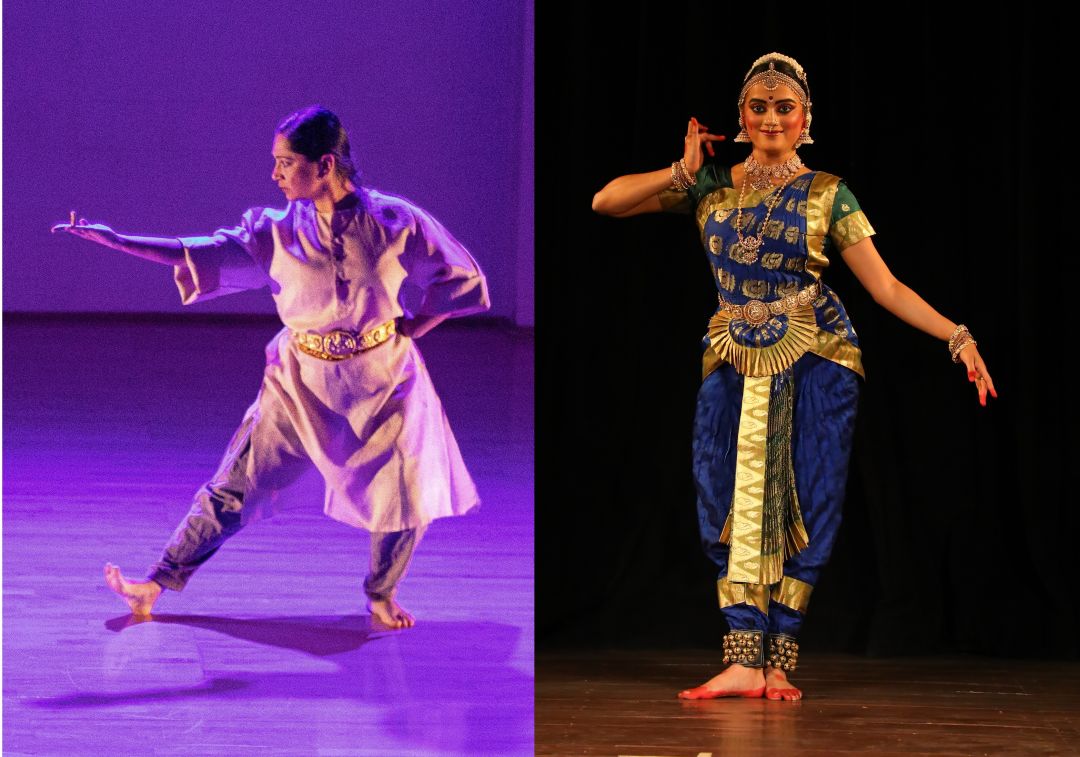Listening to Silence Asks Us to Lend An Ear

Subashina Ganesan (left) and Yashaswini Raghuram (right), the co-creators of Listening to Silence
In her pale, white-walled Southeast Portland studio, Subashini Ganesan pulls out her phone and plays me a video. The word “SILENT” appears in blocky white text on an all-black backdrop—then, one by one, the letters migrate across the screen until they spell “LISTEN.”
I react with my biggest anagram-inspired gasp since I learned "Britney Spears" contains all the same letters as "Presbyterian."
“Being silent helps the listening,” Ganesan says, grinning. “I take no credit. My husband figured it out.”
A dancer from Singapore who runs the nonprofit performance space New Expressive Works, Ganesan is Portland’s Creative Laureate—an appointment made by late city commissioner Nick Fish in 2018. Her new piece, Listening to Silence, premieres this weekend at N.E.W. She's been preparing it since October, but its roots go back decades.
It’s inspired by Ganesan’s religious studies (and not, in fact, by the Scorsese movie where Adam Driver and Andrew Garfield are long-haired missionaries), which she began as a student at the University of Rochester. Having grown up in a Hindu family, she took Hinduism as a freshman expecting an easy A.
“Yeah, no,” she says, laughing. Her first assignment was to study the Rigveda’s creation myth, a dense text that stood at odds with the more strictly representational religious parables she remembers from childhood.
“It began to pique my interest in overall abstract spiritualism,” she says. “I got a religion minor, and that’s when I sort of started to be like, ‘Oh, I’m not gonna be a scientist after all. I’m gonna do something else.’”
Listening to Silence opens with lines from that Rigveda myth—mandala 10, hymn 129—spoken by Ganesan and her co-star slash collaborator Yashaswini Raghuram. It also incorporates texts from Indian philosopher Jiddu Krishnamurti, chopped up and rearranged by Ganesan.
The theme, predictably enough, is silence: what it means, how we respond to it, what we stand to gain by paying closer attention to its nuances.
“When we’re having a conversation, am I listening to what you’re saying and responding to what I heard? Or am I making an image as you’re speaking as to my response?” Ganesan says. “That space I would take to listen to you before your response is that space of silence.”
The piece explores these concepts with a little lip service and a lot of movement. In addition to the spiritual texts, Ganesan and Raghuram discuss the cosmos—space is silent but hardly static, which Listening to Silence touches on in passages about black holes. Sometimes the pair dances to no music, their bare feet slapping on N.E.W.’s wood floor; sometimes they stand still while music plays beneath them.
The movement is striking: it incorporates the grammar of traditional Indian Bharatanatyam dance while upending the structures of a Bharatanatyam performance. Would Ganesan, who developed the choreography collaboratively with Raghuram, call it contemporary?
“I’ve gone beyond calling it something,” she says. “But it is not traditional.”
Raghuram, who met Ganesan through Anjali Indian dance school founder Anita Menon, says it’s the first time she’s colored this far outside the lines.
“I had a lot of questions,” she admits. “But it is [still] traditional in some sense, because the concept is spiritual, and that’s also the end game for any other Indian classical dance performance.”
Ganesan resists putting too fine a point on her goals for the piece—she paraphrases Austrian poet Rainer Maria Rilke, saying, “Don’t try to answer the questions; live the questions, and the answers will come”—but offers something of a spiritual takeaway.
“In these times, when we’re thinking about, ‘How do we build bridges across such vast, varying opinions,’ it seems like a good thing to pause and be and figure out what being a human really means.”
Listening to Silence
7:30 p.m. Fri–Sat and 4 p.m. Sun, Jan 31–Feb 2, New Expressive Works, $20–25




